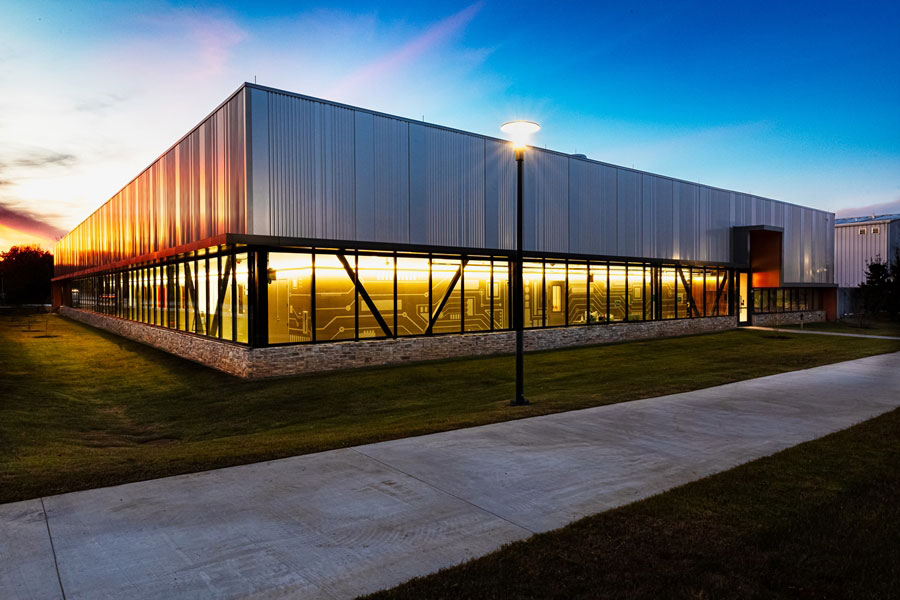News: Microelectronics
18 November 2025
University of Arkansas opens Multi-User Silicon Carbide Facility
The University of Arkansas has opened its Multi-User Silicon Carbide Facility (MUSiC), which is claimed to the only open-access fabrication facility of its kind in the USA.
MUSiC will provide domestic opportunities for prototyping, proof-of-principle demonstrations and device design incorporating SiC, and its facilities and services will be available to external researchers and industry.

Picture: The Multi-User Silicon Carbide Facility (MUSiC). Photo by Russell Cothren.
“MUSiC is a powerful example of our land-grant mission in action,” said chancellor Charles Robinson. “This facility will give students hands-on experiences that prepare them for success in a high-tech workforce while helping our researchers push the boundaries of what’s possible in materials science and semiconductor technology. In doing so, it will strengthen Arkansas’ economy, improve lives across the nation and help safeguard America’s long-term security and prosperity.”
Robinson was joined by leaders including US Representative Steve Womack and Arkansas State Attorney General Tim Griffin, as well as Kim Needy (dean of the College of Engineering) and Alan Mantooth (UA Power Group’s founding director and Distinguished Professor of Engineering). Alumni from semiconductor firms including Wolfspeed, GlobalFoundries, onsemi, Microchip and Texas Instruments also attended the opening.
“The technology that will emerge from the MUSiC fab is foundational to our economic strength and national security,” commented Womack. “The University of Arkansas will serve as ground zero for this important work, developing scalable technologies that will bolster our ability to compete in the global marketplace,” he added.
Funded partly by the US National Science Foundation’s Mid-Scale Research Infrastructure Program, MUSiC provides a multi-project wafer model enabling collaborative prototyping and research across academia, government and industry. The facility features an eight-bay cleanroom, expandable to 10 bays in Phase 2, within a 22,000ft2 building. It complements the UA Power Group’s vertically integrated research ecosystem for advancing technologies from materials to systems.
The University of Arkansas Power Group (UAPG) represents one of the USA’s most comprehensive academic programs in advanced power electronics, integrating three national centers of excellence — GRAPES, POETS, and CITES — and over $150m in core research facilities. With 24 faculty across five departments and $31m in annual research expenditures, the Power Group spans energy systems, electrified transportation, and high-power electronics innovation.
Industry and academic collaboration
Together with the High-Density Electronics Center (HiDEC) and the National Center for Reliable Electric Power Transmission (NCREPT), the MUSiC Fab anchors one of the USA’s largest academic clusters in power and energy research. This tri-center model is said to enable rapid innovation across materials science, advanced packaging, integrated circuit design and power electronics, creating a multi-disciplinary national hub for SiC and energy systems research.
“From lab to fab, MUSiC provides a clear on-ramp,” comments Tom Johnston, senior X-FAB Texas manager and chairman of the MUSiC External Advisory Board. “Its alignment with industry standards and X-FAB’s manufacturing capability helps convert prototypes into qualified, high-reliability silicon carbide devices - quickly. By standardizing interfaces and providing foundry-ready design enablement, MUSiC helps our teams move from tape-out to ramp with fewer surprise,” he adds.
“Our vertically integrated research — from materials to systems — allows us to train students, serve industry and innovate at every level of the power electronics ecosystem,” notes Mantooth.
Expanding national capability and economic impact
Arkansas now houses what it says is one of the largest academic power electronics programs in the USA, with: more than $31m in annual research expenditures; $150m in core facilities; and 24 faculty members across five departments — the largest such team in the nation.
MUSiC builds on this foundation to strengthen the USA in SiC power electronics, directly supporting energy independence, defense readiness and industrial competitiveness. It also signals the university’s growing partnership with federal agencies and leading semiconductor companies in driving next-generation energy, automotive, aerospace and defense technologies.
Investing in people
MUSiC will also serve as a hands-on training ground for U of A students and visiting researchers nationwide. By integrating fabrication, design and systems testing, it creates an educational pipeline preparing graduates for careers and research in power electronics, energy and semiconductors.
The facility’s open-access model welcomes academic, government and private-sector collaborators, offering opportunities for prototyping, small-volume production and custom process development — all designed to accelerate innovation and workforce readiness.
Building a semiconductor workforce
Beyond its technical mission, MUSiC is dedicated to cultivating the future semiconductor and AI workforce. Designed to welcome both new and transitioning workers into the industry, this initiative builds a foundation for future-ready skills in semiconductor fabrication, materials engineering and systems integration.
“MUSiC will give students from Arkansas and across the US access to world-class SiC fabrication capabilities,” Mantooth says. “That exposure will advance their skills, empower research excellence and feed directly into the nation’s energy and transportation industries,” he adds.
“By providing our students and faculty with direct access to advanced fabrication, packaging and testing environments, we are preparing the workforce that will lead America’s semiconductor renaissance,” believes Needy.
“MUSiC can help create clear pathways for building an AI and semiconductor workforce,” says Dr Ardy Sidhwa, senior advisor to Hill and Kincaid’s Excellence in Semiconductors Initiative and an active alum of the University of Arkansas. “By merging hands-on training with cutting-edge research and real-world industrial collaboration, MUSiC is redefining how the next generation of engineers, scientists and technologists will power the global SiC revolution and the AI-driven economy ahead.”
Nissin Ion collaborates with University of Arkansas’ program MUSiC









